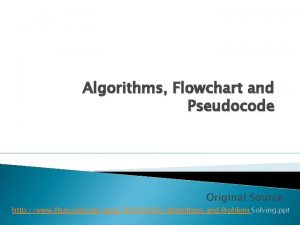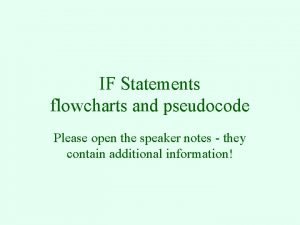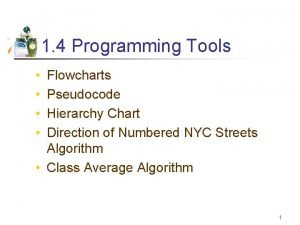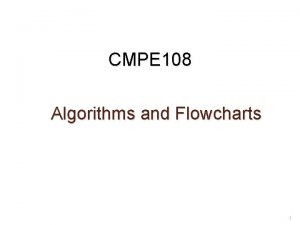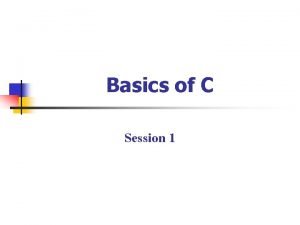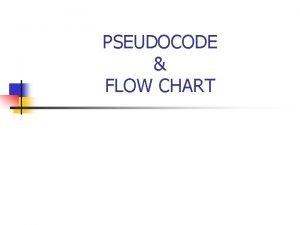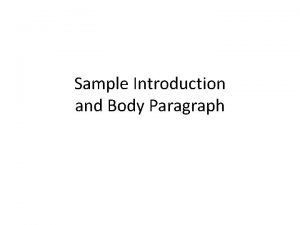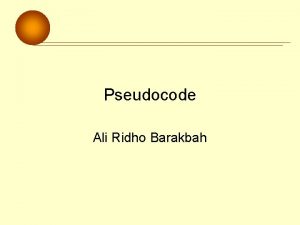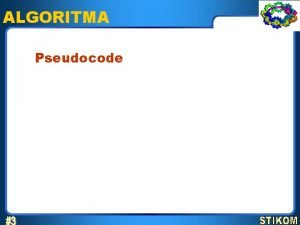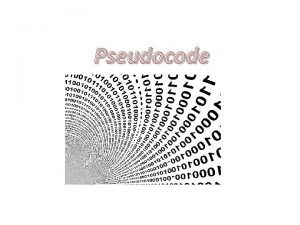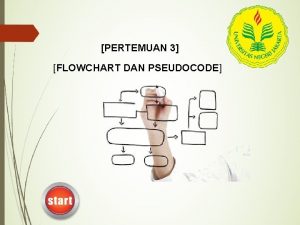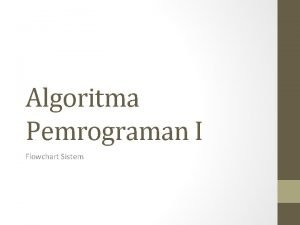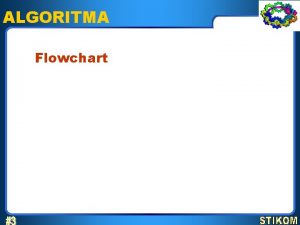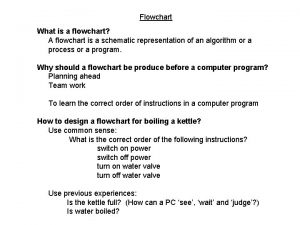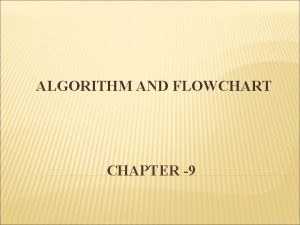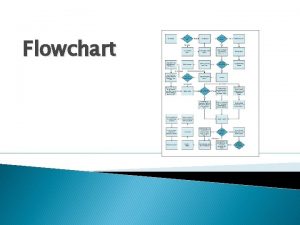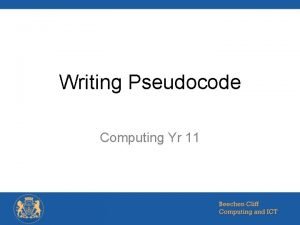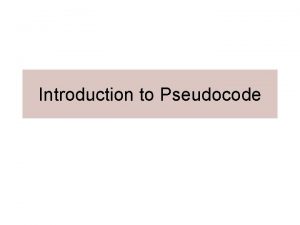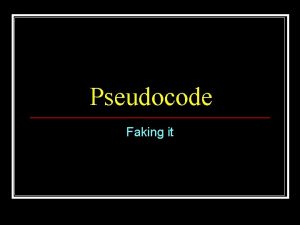PSEUDOCODE Resource Agenda Intro to Pseudocode vs Flowchart























- Slides: 23

PSEUDOCODE Resource:

Agenda Intro to Pseudocode vs Flowchart Technique – Write pseudocode Examples

What’s Pseudocode ? Artificial and Informal language Helps programmers to plan an algorithm Similar to everyday English Not an actual programming language

E. g : Pseudocode Read A, B Calculate C = A*B Display C Stop

Technique Do not write Start in every pseudocode Parallelogram – Read / Get OR Display / Print Rectangle – Specify the actions ◦ E. g: Calculate A = B + C OR A equals to B plus C Average = total / count Final price equals price of item plus sales tax Diamond – [Next » ]

Technique (. . Cont. ) Diamond ◦ Selection – IF , IF / ELSE and IF / ELSE IF IF A is less than B BIG = B SMALL = A ELSE BIG = A SMALL = B ◦ Repetition – WHILE / DO/WHILE / FOR [Next example]

Comparative Between Flowchart vs Pseudocode Flowchart ◦ A graphical way of writing pseudocode ◦ Rounded rectangle – terminal ◦ Parallelogram – input / output ◦ Rectangle – actions ◦ Diamonds – decision / conditional ◦ Circles – connector

E. g : Flowchart Start Terminal. Program start here Input. Enter values for A and B Process Output Stop Terminal Program end here

Comparative Between Flowchart vs Pseudocode (. . Cont. ) Pseudocode ◦ No syntax rule – Independent from any programming language ◦ Write in an ordinary language ◦ Uses a structure resembling computer structure ◦ No connector between pages

E. g : Pseudocode Read A, B Calculate C = A*B Display C Stop

E. g : Pseudocode Read A, B – Input Calculate C = A*B - Action Display C - Output Stop - Terminal

Example 2 (Selection) Read A, B IF A is less than B BIG = B SMALL = A ELSE BIG = A SMALL = B Write / Display BIG, SMALL Stop

Example 2 (Selection) Read A, B - Input IF A is less than B - Selection BIG = B - Action SMALL = A - Action ELSE - Selection BIG = A - Action SMALL = B - Action Write / Display BIG, SMALL - Output Stop - Terminal

Example 3 (Repetition) Set count to zero Set total to zero Read number WHILE ( not end-of-data ) increment count by 1 total = total + number read number IF ( count > 0 ) then average = total / count Display average Stop

Advantages Converting a pseudocode to a programming language is much more easier than converting a flowchart. As compared to flowchart, it is easier to modify a pseudocode of a program logic when program modifications are necessary.

Limitations In the cases of pseudocode, a graphic representation of program logic is not available. There are no standard rules to follow for using a pseudocode. ◦ Different programmers use their own style of writing pseudocode; and hence, ◦ Communication problem occurs due to lack of standardization.

Review - Pseudocode An artificial and informal language that helps programmers develop algorithms A "text-based" detail (algorithmic) design tool “Write the steps before you write the code” (Matthew Morgenstern – Computer Scientist)

Example – IF/ELSE Read student ‘s grade IF student's grade is greater than or equal to 60 Print "passed" ELSE Print "failed“ Stop

Example - WHILE Set total to zero Set grade counter to one WHILE grade counter is less than or equal to ten Input the next grade Add the grade into the total Set the class average to the total divided by ten Print the class average Stop

Example – WHILE & IF/ELSE Initialize total to zero Initialize counter to zero Input the first grade WHILE (0 <= grade <= 100) Add this grade into the total Add one to the grade counter Input the next grade (possibly the sentinel) IF the counter is not equal to zero Set the average to the total divided by the counter Print the average ELSE Print “no grades were entered” Stop

Example – WHILE & IF/ELSE IF Initialize total to zero Initialize counter to zero Input the first grade WHILE (0 <= grade <= 100) Add this grade into the total Add one to the grade counter Input the next grade (possibly the sentinel) IF the counter is not equal to zero Set the average to the total divided by the counter Print the average ELSE Print “no grades were entered” IF (80 <= grade <= 100) Print “A” ELSE IF (60 <= grade <= 79) Print “B” ELSE IF (40 <= grade <= 59) Print “C” ELSE IF (0 <= grade <= 39) Print “Fail” Stop

Example – WHILE & IF/ELSE IF Initialize total to zero Initialize counter to zero Input the first grade WHILE (0 <= grade <= 100) Add this grade into the total Add one to the grade counter Input the next grade (possibly the sentinel) IF the counter is not equal to zero Set the average to the total divided by the counter Print the average ELSE Print “no grades were entered” IF (80 <= grade <= 100) Print “A” ELSE IF (60 <= grade <= 79) Print “B” ELSE IF (40 <= grade <= 59) Print “C” ELSE IF (0 <= grade <= 39) Print “Fail” Stop

EXAMPLE – WHILE & IF/ELSE Initialize passes to zero Initialize failures to zero Initialize student to one WHILE student counter is less than or equal to ten Input the next exam result IF the student passed Add one to passes ELSE Add one to failures Add one to student counter Print the number of passes Print the number of failures IF eight or more students passed Print "raise tuition“ Stop
 Human resource management overview
Human resource management overview Human resource management lecture chapter 1
Human resource management lecture chapter 1 Agenda sistemica y agenda institucional
Agenda sistemica y agenda institucional Pseudocode for making a cup of coffee
Pseudocode for making a cup of coffee Algorithm vs flowchart
Algorithm vs flowchart Difference between algorithm and flowchart
Difference between algorithm and flowchart Pseudocode flowchart
Pseudocode flowchart What is a predefined process in a flowchart
What is a predefined process in a flowchart If then else pseudocode and flowchart
If then else pseudocode and flowchart Bjarne stroustrup
Bjarne stroustrup Pseudocode rules
Pseudocode rules Pseudocode chart
Pseudocode chart Pseudocode flowchart example
Pseudocode flowchart example Differentiate between pseudocode and flowchart
Differentiate between pseudocode and flowchart Integer
Integer Resource loading vs resource leveling
Resource loading vs resource leveling Contoh resource loading
Contoh resource loading Intro
Intro Cash cab intro
Cash cab intro Research paper parts
Research paper parts Solar system intro
Solar system intro Facebook
Facebook Intro to digital technology
Intro to digital technology Intro body conclusion example
Intro body conclusion example



